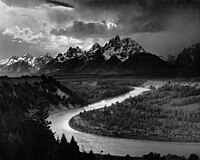
Photo from wikipedia
Abstract In this study, we investigated the mineral and geochemical compositions of the main lithotypes constituting the Atibaia and Jaguari rivers’ subbasins (Southeast Brazil), with the aims of characterizing the… Click to show full abstract
Abstract In this study, we investigated the mineral and geochemical compositions of the main lithotypes constituting the Atibaia and Jaguari rivers’ subbasins (Southeast Brazil), with the aims of characterizing the distribution of rare earth elements (REE) in that diversified geological framework and identifying their source bearing minerals to the environment at the catchment scale. Samples from six geological units comprising granitoids of monzogabbroic to granitic compositions, orthogneisses (dioritic to granitic compositions), paragneisses and local occurrences of quartzites were studied. In estimates of mineral proportions in each analyzed lithotype, we identified plagioclase, K-feldspar, and Ca-amphibole followed by minor amounts of apatite, titanite, allanite and rarely monazite as the potential light REE hosting phases, while the dominant heavy REE carriers were Na-amphibole, garnet, and zircon. The ∑REE contents in the rocks ranged between 59 and 791 mg kg−1, with a significant surplus of light over heavy REE [(La/Yb)CN = 11–197]. The whole-rock negative Eu anomalies of most samples result from the combined Eu budget of the individual minerals. Metamorphic lithotypes dominate at the Atibaia subbasin, whereas the main lithology of the Jaguari subbasin are granitoids. Comparatively, the first rocks contain slightly more ∑REE and are more enriched in light REE. These features and the relative weathering susceptibility of the REE hosting minerals constitute the initial step to explain the behavior of these elements in the environment.
Journal Title: Journal of South American Earth Sciences
Year Published: 2019
Link to full text (if available)
Share on Social Media: Sign Up to like & get
recommendations!